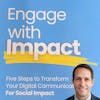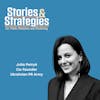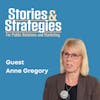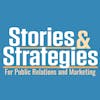Exploring the Agile Framework for Communications

In his new book Engage with Impact, Nicholas Bruneau uses interviews and case studies from the UN, EU, World Bank and nonprofit organizations to demonstrate the power of agility in corporate communications today.
A – Adopt a Startup Mentality
G – Go Digital First
I – Inspire with Personal Stories
L – Leverage Your Content
E – Empower Your Community
Listen For
7:32 Utilizing Digital Strategies Effectively
9:32 Developing On-Message Tools
16:54 Optimizing SEO
Guest: Nicholas Bruneau
Website | Email | Skype | LinkedIn
Engage with Impact Website
Check out the YouTube Trailer for the Engage with Impact book
Watch the original 2012 video Science, It’s a Girl Thing
Rate this podcast with just one click
Leave us a voice message we can share on the podcast https://www.speakpipe.com/StoriesandStrategies
Stories and Strategies Website
Do you want to podcast? Book a meeting with Doug Downs to talk about it.
Apply to be a guest on the podcast
Connect with us
LinkedIn | X | Instagram | You Tube | Facebook | Threads
Request a transcript of this episode
Doug Downs (00:02):
In 2012, the European Commission tried to do the right thing. They wanted to promote young women getting into science, so they developed a video they hoped would go viral. Unfortunately, it did. The video had slim females in miniskirts and stilettos dancing to techno music in a pink lab with the message science. It's a girl thing. The backlash was immediate sexist. The ad was pulled, epic fail, but they did get a few things right. They went digital and they did demonstrate agility by immediately removing the video, leaving room for real life female scientists to create their own videos. More on target. One could argue the campaign ultimately succeeded today on Stories and Strategies, Agility, it's a PR thing.
(01:02):
My name is Doug Downs. Just a quick note off the top, we got a great review on Apple Podcast in Canada. The author who just chose to leave their name anonymous, but the author's name is unnamedlistener. This is going to sound like I wrote it, but I promise you I didn't. Amazing review. "This podcast covers all the essential insights of public relations and marketing. I've noticed they've switched to weekly episodes, and I now look forward to listening every week. The insight is remarkable and you can really feel the quality of this podcast. All in all, I suggested this podcast to my colleagues, and now they even tune in. I highly recommend, well done." So to the person in Canada who left that review. That is fantastic. Appreciate it so much. Please do leave a review. My guest this week is Nicholas Bruneau. No pressure on you, Nicholas, with the amazing insights that are expected here. You're joining from Cascais, Portugal. How are things there?
Nicholas Bruneau (01:59):
Things are great. It's a beautiful sunny day, and so really happy to be here. Thanks a lot for the invitation. Doug
Doug Downs (02:06):
And Cascais, you were telling me is like a suburb of Lisbon, but it's the part of Lisbon where the lawns are always manicured and a little more green, and the setting is beautiful. Do I have that right?
Nicholas Bruneau (02:18):
Well, it prides itself from being close to the ocean. So we're just eight minutes from, we're a beautiful beach, but at the same time, we're about 20 minutes from Lisbon, from downtown Lisbon, so it's the best of both worlds.
Doug Downs (02:31):
No kidding. Nicholas, you are a communications consultant who's worked for intergovernmental agencies from the United Nations World Bank and the European Union, as well as nonprofits, various associations, media groups and political organizations. You've led digital advocacy campaigns on issues such as international development, education, sustainability, and climate change. And Nicholas, you've written a book, which was, honestly, I can't think of a better read for communications that I've ever had, at least one of the best books for communications I've ever read. It's called Engage With Impact, five Steps to Transform Your Digital Communications for Social Impact, and the chief premise, the Five Steps is the acronym agility. It actually does have that acronym connected to it, but explain the concept to me, and if you don't mind illustrate it using the Raise Your Hand Campaign as an example.
Nicholas Bruneau (03:34):
Absolutely. So first of all, thanks for the intro. What happened was about three years ago, I did a survey of marketing and communications experts and managers. About 236 people responded. What they said was, agility is what has changed due to the pandemic. We've had to become more agile. We've had to learn on the go, learn on the fly. That really got me to thinking, okay, there's something happening here. Communications is changing. Of course, during the pandemic, everything had to be online, so people had to really switch and learn all these new platforms very quickly. So I went further and I did about 20 interviews of different communications directors to really learn, okay, how are they succeeding online and what are the strategies that they're using? So that's the premise for the book. And one of those is one, the stories there is, as you mentioned, the Global Partnership for Education.
(04:43):
They were starting a campaign right in the middle of the pandemic. So just when it started, they were ready for a big replenishment campaign. Of course, it was all going to be in person, a lot of flights and a lot of trips, and at the end in, what was it, 2021. Then all of 2020, all of a sudden they had to change everything and it had to go online. So with their agency, they changed the campaign so that it would be all virtual so that it would also have a call to action that was online. So they created a microsite that allowed people to participate and allowed people to support the campaign for increased funding for education, but all in a virtual way. And they also tapped into the influencers to help support and the campaign to have a broader reach. So they got influencers like Michelle Obama, Didier rba, also, I forget Naomi Campbell.
(05:59):
Anyways, at the end of the day, they're really broadening out their reach, and so for the first time, they really had to change everything, and it was a real success. In the end, they ended up organizing a virtual summit, sorry, a hybrid summit, which brought together everybody in London at the end. This was at the end of the pandemic now, and they raised 4 billion in funding for education. So it was really a testament to the fact that they were able to pivot completely their strategy and go completely digital in a time where it's really difficult to explain and engage people online.
Doug Downs (06:39):
And that's a massive shift because thinking and moving on the fly has always been a part of what we do. Suddenly, I can remember leading public engagement processes and open houses where the thing at the time, and suddenly it, you'd be flooded with people, the open house didn't make sense. So you'd shift to a town hall. The shift, the agility was setting up chairs and a microphone and probably a podium at the front, but this is a different, it's a bigger, broader scale with capital impacts. So you're spending money in a different place. One tenant of agility overall in 2024, and it's hard to believe it's taken this long to get here is shifting to more of a digital strategy, but it's now something we're starting to see from the Royal family. The Vatican has a digital strategy, the United Nations. Tell me a bit about that. You write about it in the book.
Nicholas Bruneau (07:32):
Yeah, first and foremost, what I wanted to do was to really, there's all these terms like agility, disruption, digital transformation,
Doug Downs (07:43):
Paradigm Shift.
Nicholas Bruneau (07:44):
Exactly. And people are like, well, what does that mean? And how do I really implement that? These big concepts that seem to mean everything and nothing at the same time, how do I implement that? So what I wanted to do was to take a step down and really look at, okay, what are people doing to have those stories and strategies, no pun intended in the book, and to really show how people are becoming more agile. So the idea, okay, even the Vatican I was talking about, they're filming and posting right away some of their high level meetings. So you're really seeing digital diplomacy taking a step forward in the fact that all of a sudden people are becoming faster at sharing content. And actually, one of the things that the pandemic did is we don't expect now to see perfect polished content. So even you have the UN Secretary General doing a selfie with a video and speaking directly to his audience, and that you would've never seen before the pandemic. And so in a similar way, you have the World Food Program. They decided, okay, we have to be number one in video. We have to really, really up our game. They created a video booth they created that travels with the CEO, and then they're able to quickly respond when there's emergencies and then quickly film and distribute that across all their different channels. So I think agility is really being prepared, but then actually having the systems in place so that you're able to really respond quickly and not always reinvent the wheel
Doug Downs (09:32):
To respond quickly and to be agile, I think you have to listen. How do you do that?
Nicholas Bruneau (09:40):
Well, by, I think using the social media channels in a way that you're going to be able to know what's what people are talking about. And I think that social media nowadays is being seen more as a broadcast medium. Very few people are really listening to what's happening. So they're not using that information. And there's a lot of tools that allow you to really listen. And actually that's one of the strategies, for example, if you want to counter or even preempt disinformation, is to be able to see, okay, what are people saying about me, either my branch or my organization, or a specific topic, and how can I then understand the concerns of those people and then respond to that in my content? So it's really about getting to know your audience and making the effort to really see what they're talking about as opposed to just broadcasting and broadcasting, which is unfortunately what a lot of us are seeing nowadays.
Doug Downs (10:46):
Perfect. Another thing that you talk about in the book is the idea of an on message tool. Back in the nineties and early two thousands, we would develop wallet cards for our executives, and they'd have the punchy three corporate lines. So similar, what you're talking about is a kind of matrix for high level messaging, but across a variety of issues and a variety of audiences.
Nicholas Bruneau (11:14):
Yeah. Yeah. I mean, I think once again, if you want to be quick, you've got to have your messages already done packed, right? And so how do you do that on an issue, whether that was constantly changing or climate change that is also, there's always new messages and new things going on, or the war in Ukraine, for example. So you've got to be on your toes. And so it is actually an opportunity, it's an opportunity for communications leaders to develop something that internally they're working with the people responsible for policy, the people responsible for security, they're working with the C-suites, and they're creating something that is a very one pager that allows people to sort of very quickly get the facts, get the latest information, the latest data. And so that was the on-message template that the Global Partnership for Education developed during the pandemic.
(12:13):
And it was so popular that now they do it for key issues like climate change, the war in Ukraine and things like that. Where Laos is, particularly for distributed organizations, if someone is in Hong Kong and another in New York, the person in Hong Kong is going to have access to the right information for their speech right away or for a media interview or for a presentation. So it allows people to be really connected. And then what it also does is that it allows more collaboration internally because you have to keep these updated. You have to constantly work with all your teams internally to make sure that the data is updated. So really it's a win-win in that way,
Doug Downs (12:59):
Engaging with journalists. The traditional way is through a press release. I've always just loved that term because nobody pressing nothing these days, but that's the term press release. Not that the press release is dead. There probably is a purpose at the top of the funnel for the press release. But dive into that for me. What are the best ways to engage with journalists in 2024?
Nicholas Bruneau (13:24):
Yeah, exactly. Exactly. I'm not going to say exactly that the press release is dead because it's not the case, but we're both Canadian, and so you'll know the Canadian philosopher, Marshall McLuhan who said the medium is a message. So he said that back in the day for radio and tv. But today it's even more relevant because we're talking about digital and communicating for a digital audience and for a world that basically is distracted after five seconds, and we need, we're constantly fed information. So how do you sort of deal with that? And that's changing the way that your press release is. So it's more visual has to have a lot more elements as far as the social media elements to it. But other examples are, for example, the EU Drugs Agency, they've decided that they are going to invest in data and a data platform because data journalism allows them to sort of communicate in a different way and allows journalists to then create visual stories. So they've really invested in data, and that allows them to really connect in a different way with journalists. So I think that's the key thing, is to be creative and to give journalists the tools so it makes their job easier. They have access to the data, or they have access to already some social media posts or even different videos and photos that it makes their job easier.
Doug Downs (15:03):
Can you give me an example of where that has worked for you, where maybe you have a relationship with a journalist online or you don't, but you manage to engage them via an online interaction?
Nicholas Bruneau (15:14):
Yeah. I think that, once again, for the press release, it's also their people as well. The journalists will, they'll appreciate being up to date on social media with what you're doing, not just when something happens. And so sometimes it's just the power of a direct message directly when there's an event. For example, you should be following already the journalists that are going to be at that event. And then you should also try to direct message. So it's a personal way of using social media that allows you to sort of say, okay, this is my story. Not just sending out a big press release to hoping that it gets picked up, but really having a personal approach and using social media that way.
Doug Downs (16:10):
And I'll give you an example. You and me, you and I, or me, we met online together on LinkedIn. We connected because we have mutual interests. And when your book came out, you sent me a note, a message on LinkedIn saying, Hey, what do you think? And would it fit for an episode for the podcast? I said, send me the book. Had a look at the book and thought, well, there's two episodes or more in here. So that's just a prime example. It's always been relationships and the press release. Terrific, terrific. Go ahead, do a press release. But understand, you're at the top of the funnel, and the most you're doing is just sort of getting attention. Don't expect action out of the press release.
Nicholas Bruneau (16:54):
Exactly. So building that relationship, but over time and not just when something happens. And that's, yeah, that is the power of social media
Doug Downs (17:03):
Power of SEO, search engine optimization. We're morphing the way we think about SEO. We've been in a world where it's keywords, and ironically, in the podcast world, it is still keywords because the algorithms are completely antiquated. But in the rest of the world, it's less and less about keywords and more about sentimentality. With search engine optimization, it's getting sophisticated. Talk to me about SEO.
Nicholas Bruneau (17:30):
Yeah, I mean, when something happens, what's the first thing you do, right? You're going to Google it. You're going to see, okay, what's going on? When there's a new, for example, if I talked to the head of an association and she said, of course we have to be there when there's a new law, for example, because the first thing these lawmakers are going to do, they're going to Google, or when there's a new proposal for a law, they're going to Google that issue. And we need to be top of mind and we need to rank according to that issue.
(18:03):
So even on a policy level, it's not just basically, I think that people forget that even if you're not selling any products, you still want to rank high on your keywords, whatever those are. And that's for example, what happened with World Bank. So I was working at the World Bank at the time, and they had a big focus on SEO, and I was wondering why, because they realized that they have all this great content, but nobody reads it. So there's all these amazing reports and analysis and stuff, but only a very small amount of people read it. So what they did is they said, let's invest in SEO, let's invest in SEO copywriting. So to make sure that our titles get people's attention, to make sure that we're using the right search engine optimization across all of our content. And what they told me then after that was, Hey, now we're getting much more visibility. And also we're building trust online because people are going back to our content and sharing our content. So it's been really positive for them.
Doug Downs (19:17):
Excellent. Next episode, because there's more to the book, I want to cover more, including virtual influencers. And you've got a killer, you've got several killer examples, but one that completely stood out to me, just amazing why personal stories are so powerful and helping communities feel empowered. Keyword there is that the communities need to feel empowered. And it's not that the entity can empower the community, the entity or the organization doesn't have the power to do so. And if it does, you have a top-down structure. The community can feel empowered. Meantime, the Agility framework is also available online. Where can people click to check out the agility framework that you've developed?
Nicholas Bruneau (20:05):
Sure. I mean, it's really simple. It's just going to the website, which is engage with impact.com. So there you'll have more information about the book and then also more information about the Agile framework.
Doug Downs (20:17):
And as you would guess, there's a link in the show notes. Nicholas, thanks for your time.
Nicholas Bruneau (20:21):
Thank you. Doug.
Doug Downs (20:23):
If you'd like to send a message to my guest, Nicholas Bruno, we've got his contact information in the show notes as well as the link to that agility framework and the book stories and strategies as a co-production of JGR Communications and Stories and Strategies, podcasts. If you like this episode, please leave a rating, possibly a review. We read those reviews, obviously right on the show. Those mean the world to us. And lastly, do us a favor forward this episode to one friend. Thanks for listening.













